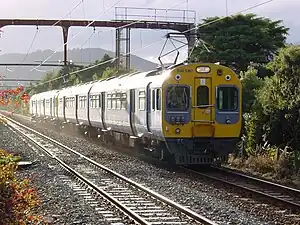Motor coach (rail)
A motor coach (international usage) or motorcar (US usage) is a self-propelled passenger vehicle also capable of hauling a train.[1][2] With multiple unit train control, one operator can control several "motor coaches", possibly even combined with locomotives, efficiently in the same train, making longer trains possible.

| Multiple unit trains |
|---|
| Subtypes |
| Technology |
| By country |
Motor coaches can replace locomotives at the head of local passenger or freight trains. Especially electrified narrow gauge lines on the European continent often saw this form of operation. Many of these railways closed down, and many others changed to electric multiple units. However, a few lines in Switzerland, Italy and Austria still work with train consists hauled by motor coaches. It can be expected that the Bernina line of Rhaetian Railway will continue for a long time to be operated with motor coaches pulling passenger and freight trains.
Examples of motor coaches
 Two motor coaches of RhB in MU pulling the maximum allowed load of 140 t on the Bernina line
Two motor coaches of RhB in MU pulling the maximum allowed load of 140 t on the Bernina line An old Bodensee-Toggenburg (Switzerland) motor coach pulling four coaches: not an EMU and not a railcar
An old Bodensee-Toggenburg (Switzerland) motor coach pulling four coaches: not an EMU and not a railcar Electric motor coach of CEV (Switzerland) with driving trailer
Electric motor coach of CEV (Switzerland) with driving trailer Metre-gauge electric twin motor coach ABDe 8/8 4004 of the Montreux–Lenk im Simmental line in Switzerland pulling two coaches and two cement wagons
Metre-gauge electric twin motor coach ABDe 8/8 4004 of the Montreux–Lenk im Simmental line in Switzerland pulling two coaches and two cement wagons A Czech diesel motor coach with a driving trailer
A Czech diesel motor coach with a driving trailer
Examples of railcars
 ARB BCFhe 2/3 6 in Switzerland, oldest operational rack railcar of the world, built in 1911
ARB BCFhe 2/3 6 in Switzerland, oldest operational rack railcar of the world, built in 1911 Soviet railcar AS1A at Museum of the Moscow Railway (Moscow Rizhsky station)
Soviet railcar AS1A at Museum of the Moscow Railway (Moscow Rizhsky station) Czech railbus (now nicknamed Regiomouse)
Czech railbus (now nicknamed Regiomouse).jpg.webp) Rack railcars of Gornergratbahn in Zermatt, Switzerland
Rack railcars of Gornergratbahn in Zermatt, Switzerland
Examples of multiple units not combined with other vehicles
 Rack electric multiple units of Gornergratbahn in Zermatt, Switzerland: Two-car-units can work in MU
Rack electric multiple units of Gornergratbahn in Zermatt, Switzerland: Two-car-units can work in MU Two rack GTW of the Ferrocarrils de la Generalitat de Catalunya working in MU on the Montserrat line
Two rack GTW of the Ferrocarrils de la Generalitat de Catalunya working in MU on the Montserrat line ZSSK Class 405.95 on the Štrba to Štrbské Pleso rack railway, Štrbské Pleso
ZSSK Class 405.95 on the Štrba to Štrbské Pleso rack railway, Štrbské Pleso Two EM class EMUs in New Zealand
Two EM class EMUs in New Zealand Bilevel EMUs in Chicago
Bilevel EMUs in Chicago An MU of Silverliners of Southeastern Pennsylvania Transportation Authority (SEPTA)
An MU of Silverliners of Southeastern Pennsylvania Transportation Authority (SEPTA) Sankt Petersburg Metro EMUs
Sankt Petersburg Metro EMUs
See also
Categories
General
References
- Ellis 2006, p. 222.
- Jackson 2006, p. 216.